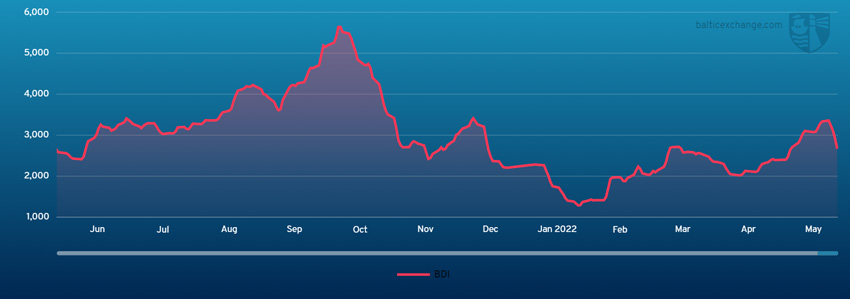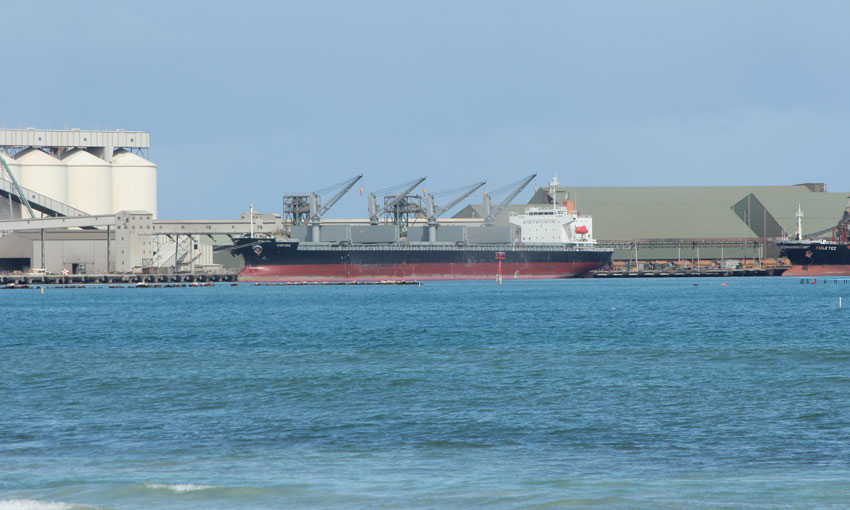THE Baltic Dry Index fell off a bit of a cliff last week, with a precipitous decline over the five days to Friday.
The BDI was 2681 on Friday (27 May), which is a decrease of 20% on the previous Friday (3344). The index increased on Monday to a peak of 3369, then fell throughout the rest of the week.

Capesize
This week, the tailwinds turned to headwinds for the Capesize market as a dip in values amongst bearish sentiment was evident for most regions.
The Pacific Ocean trade had the charterers in the driving seat as they often managed to achieve lower than last done fixing levels throughout the week as they encountered ample tonnage options. This was reflected on the C5 West Australia to Qingdao route as it opened the week at US$15.05 to close at US$11.741, while the Transpacific C10 closed at US$19,313.
With the driving force of the Pacific basin now waning, the Atlantic region has followed suit. With low spot market cargo levels and tonnage building in the area, the return to lower levels looks likely. The Transatlantic C8 dropped to US$22,100 by Friday. Ballaster tonnage for the South Africa and Brazil to Far East trade is heard to be building, coinciding with some sharp drops in the Tubarao to Qingdao C3 route, which now stands at US$31.675.
Backhaul trade, which has been in hot form lately was quieter this week, while a more standard shorter variant of backhaul trade from South Africa to the Continent was heard fixing at much lower than published levels. This set the bar down considerably lower on the C16 Backhaul route, almost halving the value by week’s end to US$17,350.
Panamax
A week of negativity engulfed the Panamax market with all rates falling sharply. Reduced fixing volumes and a buildup of tonnage in most origins gave charterers the upper hand and reduced bids consequently became common theme.
The Atlantic lacked any real demand both in the north and the south this week. Ballaster tonnage began to show signs of under pinning rates and several APS load port deals were now concluded and being traded. Earlier in the week a 82,000-dwt delivery Gibraltar was able to achieve US$29,500 for a transatlantic round via North Coast South America, but such levels were unrepeatable by the end week.
Asia began the week with some healthy NoPac demand and an 81,000-dwt delivery Japan achieved a rate of just over US$30,000, albeit on a pet coke trip which normally commands a premium. However, rates by the end of the week for standard Australia/NoPac trips were reduced to being traded at closer to US$26,000 levels.
Ultramax/Supramax
A rather protracted week as widespread European holidays dimmed activity levels. Sentiment eased in most areas as the week closed.
The Atlantic saw limited fresh enquiry from key areas such as the US Gulf whilst further south, East Coast South America remained finally balanced.
From Asia, the week started on an optimistic note. However, there was limited fresh enquiry from the south which saw an easing in owners expectations. Further north there was a more positive feel again, but as the week closed this was being eroded. Period activity saw a 63,000-dwt open Jakarta fixing minimum to about six months trading at US$36,500.
In the Atlantic, a little more activity was seen from the Continent. A 56,000-dwt open Antwerp was heard fixed for trip East Mediterranean at US$26,000. Whilst in the Mediterranean a 58,000-dwt open Algeria fixed a trip to West Africa at US$29,000. From Asia, a 63,00-dwt open Surabaya was fixed for a trip redelivery China in the mid US$30,000s.
Handysize
With holidays in large parts of Europe and many places round the world, activity was limited.
In the US Gulf a 36,000-dwt was fixed for a trip to the UK – Continent with an intended cargo of wood pellets at US$32,000. A 39,0000-dwt was fixed from Norfolk for a trip to East Coast Mexico with an intended cargo of Coal at US$34,000. A 28,000-dwt was fixed for a trip from Istanbul via Bourgas to Tunisia with an intended cargo of grains at US$21,250.
In Asia a 28,000-dwt was fixed from Matsure for end May delivery via Australia to the Continent at US$31,500 and a 38,000-dwt was fixed from China to South Africa with an intended cargo of steels at US$38,000. In China period enquiry remained active and a 38,000-dwt had rumoured to have seen low US$30,000s for short period but was holding out for higher levels.
Clean
LRs in the Middle East Gulf have again softened this week with available tonnage accumulating and open enquiry reducing. TC1 75k Middle East Gulf/Japan has lost 36.07 points to WS226.43 and its round trip TCE dropping just below US$35k/day. TC5 55k Middle East Gulf/Japan has also taken a similar hit and dipped 28.22 points to WS273.57. An LR1 trip west (TC8) has also lost nearly US$10/pmt this week and currently sits at US$65/pmt (US$4.225m).
TC17 35kt Middle East Gulf/East Africa has traded softer this week we believe off the back of the LR market direction. The index has dropped 15.42 points to WS369.58.
In the west, the LR2s have been following a similar pattern to the AG market. TC15 has dropped to below US$4m for the first time since the beginning of May, currently pegged at US$3.98m (-US$650K). The LR1s of TC16 look to have plateaued at WS240 for the moment.
MRs in North West Europe have been sideways/soft this week with a fluctuating balance between available tonnage and demand. TC2 37k UK-Continent/US Atlantic Coast came off 13.34 points to WS329.44 and TC19 37k UK-Continent/West Africa followed suit to WS340 (-12.14).
In the US Gulf freight rates have been volatile this week. TC14 38k US Gulf/UK-Continent has settled back down at WS275 for the moment after peaking around WS300 midweek. TC18 38k US Gulf/Brazil behaved similarly and ended up at WS372.86 after topping out at WS399.
The MR Atlantic basket TCE dropped from US$56,016/day to US$50,570/day.
In the Handymax sector, enquiry slowed on TC6 with a geographical spread opening in the market and the index dropped 82.13 points to WS446.18. In the Baltic TC9 managed to tick up five points to WS429.29.
VLCC
VLCC rates were very slightly firmer this week, although it appears the higher bunker price have nullified these rate rises in terms of income. 280,000mt Middle East Gulf/USG (via Cape of Good Hope) is assessed half a point higher at WS24.7, with Exxon reported on subs for a trip to the Continent via the Suez Canal at WS24.75.
Meanwhile, rates for the 270,000mt Middle East Gulf/China trip improved by just over half a point to WS41.6 (a round trip TCE of minus US$17,800 per day). In the Atlantic market the rate for 260,000mt West Africa/China improved almost 1.5 points to WS45 (minus US$13,100 per day round-trip TCE) while the rate for 270,000mt US Gulf/China voyage improved by US$43,750 to US$5.33m (a round voyage TCE of minus US$15,600 per day).
Suezmax
Rates for the 135,000mt Black Sea/Augusta route fell 1.5 points this week to just below WS113 (a round-trip TCE of US$18,000 per day), with one fixture reported on this route – an oil trader relet to Exxon at WS107.5. With a very active Atlantic market, specifically West African, South American and US Gulf load ports, rates for 130,000mt Nigeria/UKC have climbed up 12.5 points to WS103 (a round-trip TCE of about US$14,100 per day). In the Middle East, fixing activity has been steady this week while the list of available tonnage has dwindled. This is in part due to the more attractive Atlantic market pulling ballasters from the East to the West. Consequently rates for 140,000mt Basra/West Mediterranean have leapt almost 12 points to about WS56. Several ships were reported on subjects to a Turkish refiner alongside reports of French and British oil companies also fixing into Europe from the Middle East Gulf.
Aframax
The 80,000mt Ceyhan/Mediterranean market lost another three points this week to about WS124 (a round-trip TCE of about US$9300). In Northern Europe rates remained flat, at about WS140 for the 80,000mt Hound Point/UK Continent trip, and just below WS165 for the 100,000mt Primorsk/UK Cont route which shows a round trip TCE of US$15,800/day and US$35,700/day respectively.
Across the Atlantic, the markets continued on an upward trajectory. Rates for the shorter-haul 70,000mt EC Mexico/US Gulf route jumped 26 points to between WS215-217.5 range (a round-trip TCE of US$35,500 per day) and for the 70,000mt Caribbean/US Gulf route rates ascended 25 points to WS205 (a round-trip TCE of about US$28,400 per day). For the transatlantic trip of 70,000mt US Gulf/UK Continent, rates rose another 26 points close to WS195 (US$25,700 per day round-tip TCE). This is enticing some owners to ballast from Southern Europe and Mediterranean regions.

